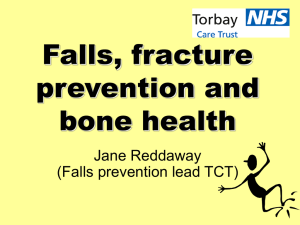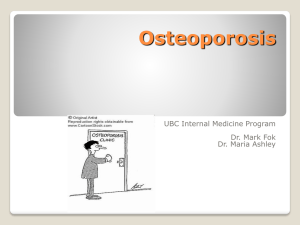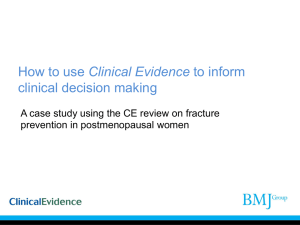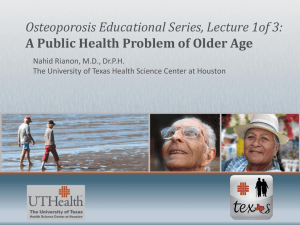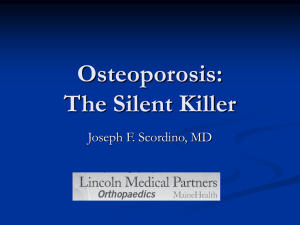Practical guidelines for orthopedic surgeons on the management of
advertisement
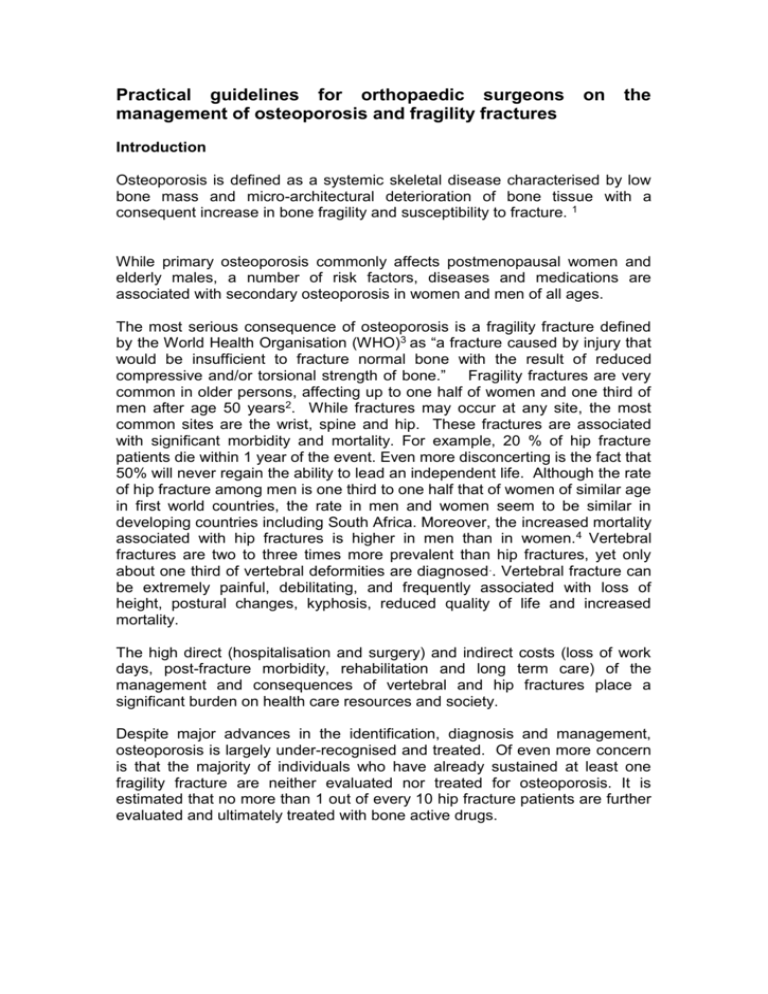
Practical guidelines for orthopaedic surgeons management of osteoporosis and fragility fractures on the Introduction Osteoporosis is defined as a systemic skeletal disease characterised by low bone mass and micro-architectural deterioration of bone tissue with a consequent increase in bone fragility and susceptibility to fracture. 1 While primary osteoporosis commonly affects postmenopausal women and elderly males, a number of risk factors, diseases and medications are associated with secondary osteoporosis in women and men of all ages. The most serious consequence of osteoporosis is a fragility fracture defined by the World Health Organisation (WHO)3 as “a fracture caused by injury that would be insufficient to fracture normal bone with the result of reduced compressive and/or torsional strength of bone.” Fragility fractures are very common in older persons, affecting up to one half of women and one third of men after age 50 years2. While fractures may occur at any site, the most common sites are the wrist, spine and hip. These fractures are associated with significant morbidity and mortality. For example, 20 % of hip fracture patients die within 1 year of the event. Even more disconcerting is the fact that 50% will never regain the ability to lead an independent life. Although the rate of hip fracture among men is one third to one half that of women of similar age in first world countries, the rate in men and women seem to be similar in developing countries including South Africa. Moreover, the increased mortality associated with hip fractures is higher in men than in women. 4 Vertebral fractures are two to three times more prevalent than hip fractures, yet only about one third of vertebral deformities are diagnosed.. Vertebral fracture can be extremely painful, debilitating, and frequently associated with loss of height, postural changes, kyphosis, reduced quality of life and increased mortality. The high direct (hospitalisation and surgery) and indirect costs (loss of work days, post-fracture morbidity, rehabilitation and long term care) of the management and consequences of vertebral and hip fractures place a significant burden on health care resources and society. Despite major advances in the identification, diagnosis and management, osteoporosis is largely under-recognised and treated. Of even more concern is that the majority of individuals who have already sustained at least one fragility fracture are neither evaluated nor treated for osteoporosis. It is estimated that no more than 1 out of every 10 hip fracture patients are further evaluated and ultimately treated with bone active drugs. The role of the orthopaedic surgeon Recognising the impact and importance of osteoporosis prevention and management, the World Orthopaedic Osteoporosis Organisation (WOOO), the American Academy of Orthopaedic Surgeons (AAOS), the British Orthopaedic Association and the Canadian Orthopaedics Associations, amongst others, have published guidelines for the evaluation and treatment of osteoporosis and to dispel the myths of osteoporosis. Orthopaedic myths 7 Osteoporosis evaluation takes too much time Prevention is ineffective Treatment is ineffective Treatment is difficult Other doctors will take the responsibility Treatment impairs fracture healing Once a fracture has occurred, it is too late Orthopaedic surgeons are uniquely placed for identifying patients at risk of osteoporosis and fragility fractures. Patients may present with one or more of the following: 1. An acute or prior fragility fracture at the wrist, spine or hip. These patients are at the highest risk of developing future fragility fractures and should be commenced on bone specific treatment. Patients with a non-spine fracture have approximately a two-fold greater risk for future fractures than do individuals who have not had a fracture. Up to half of patients with a prior vertebral fracture will experience additional vertebral fractures within 3 years and any fracture within the first year. Compared with individuals with no history of vertebral fracture, a patient with a prior vertebral fracture has nearly a five-fold increased risk of future vertebral fractures and a two- threefold increased risk of hip and other non-vertebral fractures. 2. Diseases/disorders associated with osteoporosis and/or fractures (e.g. rheumatoid arthritis, ankylosing spondylitis and prolonged immobilization). 3. Osteopenia on routine radiographs symptoms including backache). (e.g.done 4. Lifestyle and other risk factors (see tables below). for musculoskeletal Factors that identify people who should be assessed for osteoporosis 8 Major risk factors Minor risk factors Age > 65 years Rheumatoid arthritis Vertebral compression fracture Past history of clinical hyperthyroidism Fragility fracture after age 40 Chronic anticonvulsant therapy Family history of osteoporotic fracture (especially maternal Low dietary calcium intake hip fracture) Smoker Systemic glucocorticoid Excessive alcohol intake therapy of > 3 months duration Weight <57kg Malabsorption syndrome Weight loss >10% of weight at Primary hyperparathyroidism age 25 Propensity to fall Chronic heparin therapy Osteopenia apparent on X-ray film Hypogonadism Early menopause (before age 45) Adapted from Brown JP et al Council of the Osteoporosis Society of Canada Major Risk Factors for Osteoporotic Fractures6 Not Possibly Modifiable* Modifiable* Advanced Low bone mineral density age Female sex Oral glucocorticoid use Personal Recurrent falls history of adult fracture History of Current cigarette use fracture in first-degree relative Dementia Alcoholism Poor Estrogen deficiency, including menopause onset before age health/frailty 45 years Caucasian or Lifelong low calcium intake Asian race Low body weight Little or no physical activity __________________________________________________ * Adapted from Bouxsein ML et al Diseases and Drugs Associated With an Increased Risk of Generalized Osteoporosis and/or Fractures in Adults6 Diseases** Drug Therapies** Rheumatoid arthritis Oral glucocorticoids Type 1 diabetes mellitus Heparin (high doses or prolonged use) Multiple sclerosis Excess thyroid medication Nutritional disorders (especially Aromatase inhibitors vitamin D deficiency) Osteogenesis imperfecta Tamoxifen Renal disease Anticonvulsants Ankylosing spondylitis Immunosuppressants Prolonged immobilization Testosterone antagonists **Adapted from Bouxsein ML et al Guidelines on special investigations 1. Conventional skeletal radiography Conventional radiographs are useful for the diagnosis of fractures and to exclude other conditions such as hyperparathyroidism. Radiographs may also alert the physician to the presence of osteoporosis but are not reliable since 30-40% of skeletal mass must be lost before osteopenia can be detected9. 2. Dual Energy X-ray absorptiometry (DXA) The WHO criteria for diagnosis of osteoporosis are based on the bone mineral density measurement at the hip and spine. DXA is the gold standard for the measurement of bone mineral density (BMD) at the spine and hip due to its accuracy, precision and reproducibility. Indications for BMD include the presence of a fragility fracture, disorders associated with osteoporosis, more than one risk factor for osteoporosis, osteopenia on radiographs and for monitoring of patients on treatment. 3. Biochemical investigations Limited serological tests are indicated in all patients to exclude causes of osteopenia other than osteoporosis e.g. primary hyperparathyroidism, osteomalacia. Usually a serum calcium (corrected for albumin), phosphate and alkaline phosphatase would suffice. In subjects with a low bone mass, causes of secondary osteoporosis should also be excluded employing a full blood count and sedimentation rate (ESR), serum protein electrophoresis, a serum creatinine and serum gonadotrophins (LH, FSH) and testosterone (men) or oestradiol (women where menopausal state is unknown). Further specialised investigations will be determined by the clinical examination of the patient. 4. Biochemical parameters of bone turnover Biochemical markers of formation and resorption are not routinely recommended, but have been used to identify patients at risk of rapid bone loss, those at risk of fracture independent of BMD, help rationalise the therapy of osteoporosis and to monitor/predict the response to therapy. Guidelines on management Management should include Identification of patients with osteoporosis, measures to prevent further bone loss and fractures, pharmacological Intervention for established osteoporosis and follow-up and rehabilitative measures. 1. Identification A proactive approach should be taken to identify patients on history and examination of risk factors for osteoporosis and/or fractures and to institute further evaluation and treatment. Risk factors for osteoporotic fractures should not be considered to be independent of one another, they are additive and must be considered in the context of baseline age and sex-related risks of fracture. For example, a 55 year old with low BMD is at significantly less risk than a 75 year old with the same low BMD. A person with low BMD and a prior fragility fracture is at considerably more risk than another person with the same low BMD and no fracture. Where appropriate the BMD should be measured and routine biochemical assessment performed to confirm the diagnosis of osteoporosis and exclude common secondary causes. 2. Prevention Preventative therapy plays a major role. The American National Osteoporosis Foundation10 recommends that all patients: a) Obtain an adequate dietary intake of calcium (at least 1,200 mg per day), including supplements if necessary. b) Institute regular weight-bearing and muscle strengthening exercise to reduce the risk of falls and fractures c) Avoid smoking and to keep alcohol intake at a moderate level d) Correct risks associated with falls such as bad vision 3. Pharmacological Intervention The ultimate goal in treating osteoporosis is to prevent subsequent fractures. Randomized, placebo-controlled clinical trials involving large populations of women with osteoporosis, have demonstrated the anti-fracture efficacy of several agents, including bisphosphonates (alendronate, risedronate), hormone therapy, selective estrogen receptor modulators (raloxifene), calcitonin, parathyroid hormone (teriparatide) and strontium ranelate (protos). The choice of agent will depend on the patient’s clinical profile, age, presence of co-morbid conditions, site and severity of bone loss and safety and efficacy profiles of the various agents. Evidence of Antifracture Efficacy of agents to treat osteoporosis*2 Fracture Type Vertebral Hip Nonvertebral† Bisphosphonates Alendronate (Fosamax) A‡ A A Risedronate (Actonel) A A A Etidronate A C C Estrogen replacement therapy (HRT) A A A SERMs (Raloxifene) A C C Calcitonin, intranasal (Miacalcic) A C C Teriparatide (hPTH [1-34] A A A Calcium and vitamin D Preparations Vitamin D monotherapy and C C C analogs Calcium monotherapy B C C Vitamin D plus calcium B A A * Adapted from Mary L Bouxsein, PhD, et al † Nonvertebral fractures; osteoporotic fractures exclusive of the spine ‡ Also in men A = convincing evidence of antifracture efficacy, B = inconsistent results, C = ineffective, or insufficient evidence of efficacy HRT = hormone replacement therapy, SERM = selective estrogen receptor modulator Adapted from Bouxsein ML et al 4. Follow-up and rehabilitative measures Follow -up DXA scans are recommended every 1 – 2 years to monitor BMD response of pharmacological intervention. Patients with an inadequate response, further bone loss or new fracture should be referred for further investigation and management. Active physical programs should be prescribed and monitored to keep the patient’s fitness to a maximum. Interpretation of BMD World Health Organization Diagnostic Criteria for women without fragility fractures3 Diagnosis BMD criteria Normal BMD value within 1 SD of the young adult mean Osteopenia BMD value between -1 SD and -2.5 SD below the young adult mean Osteoporosis BMD value at least -2.5 SD below the young adult mean BMD = bone mineral density; SD = standard deviation Conclusion Osteoporosis is a common disease with a significant mortality and morbidity. The orthopaedic surgeon has an important role in identifying patients at risk and instituting or referring the patient for cost effective investigation, prevention and management to decrease the burden of osteoporosis, decrease fracture risk and improve the quality of life of many patients. Patient with Risk Factors -low trauma fracture, regular steroid use, family history of osteoporosis, regular/heavy alcohol use, anti-seizure medicine, smoking, small body frame, poor calcium intake, malabsorption syndrome. Patient with Risk Factors + Fragility Fracture Treat the fracture Exclude secondary causes (ESR, full blood count, serum Ca, alkaline phosphatase, creatinine, phosphate,albumin, protein electrophoresis, sex hormones) Secondary cause No secondary cause BMD Confirm secondary cause and treat T-score -1 to 1.5 with risk factors Non-pharmacological Fitness Diet Follow-up 1 – 2 yearly T-score <-1.5 to -2.5 with fracture or other major risk factors (e.g. glucocorticoids) T-score <-2.5 with no fracture Consider active treatment Monitor 1 – 2 yearly Identification and prevention of osteoporosis is still the top priority. The major problem for orthopaedic surgeons is the elderly with fragility fractures due to osteoporosis and possible co-morbid conditions Identifying, diagnosing and monitoring the treatment of osteoporosis by a full radiologic, densitometric and biochemical evaluation is mandatory. The orthopaedic surgeon must look past the myths of osteoporosis and apart from managing fragility fractures, treat the patient as a whole to maintain bone mass and quality of life. References 1 Consensus Development Conference, Prophylaxis and treatment of osteoporosis. Am J Med. 1991;90:107-110 2 Facts and statistics about osteoporosis and its impact. Accessed from www.osteofound.org/press_centre/fact_sheethtml on 18/07/2005 3 Guidelines for preclinical evaluation and clinical trials in osteoporosis Geneva: WHO: 1998:59l 4 Center JR, Nguyen TV, Schneider D, Sambrook PN, Eisman JA: Mortality after all major types of osteoporotic fracture in men and women: A observational study. Lancet 1999;353:878-882 5 Black DM, Cummings SR, Karpt DB, et al: Randomised trial of effect of alendronate on risk of fracture in women with existing vertebral fractures: Fracture Intervention Trial Research Group Lancet 1996;348:1535-1541 6 Bouxsein ML, Kaufman J, et al Recommendations for Optimal Care of the Osteoporotic Fracture Patient to Reduce the Risk of Future Fracture J Am Acad Orthop Surg 2004;12:385-395 7 J Kaufman “The role and responsibility of the orthopaedic surgeon in treating osteoporosis” at the 6th Congress of the European Federation of national Associations of Orthopaedics and Traumatology, Helsinki, Finland, June 4-10 8 Brown JP, Josse RG for the Scientific Advisory Council of the Osteoporosis Society of Canada. 2002 Clinical practice guidelines for the diagnosis and management of osteoporosis in Canada 9 Osteoporosis Clinical Guidelines South African Medical Association and NOFSA Working Group. S Afr Med J 2000, 90. (9): 905-944 10 National Osteoporosis Foundation; Physician’s Guide to the Prevention and Treatment of Osteoporosis. Washington, DC: National Osteoporosis Foundation, 2003


